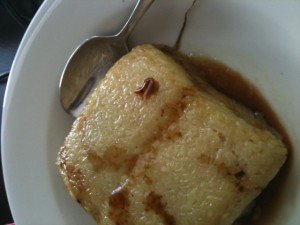Chuc mung nam moi!
Translated from Vietnamese to English, this means "Happy New Year!" Growing up in Alief where there was a Vietnamese-American presence, most all of my non-Viet friends knew this phrase. And today, I say it to you as it's the New Year, according to the lunar calendar.
There are many customs practiced during Tet, or Lunar New Year. For days and even weeks leading up to the New Year, households prepare for the impending celebration by cleaning house, cooking, repaying debts, buying new clothes, etc. How you spend the New year, the Vietnamese and Chinese believe, dictates how the rest of your year will be. It is considered bad luck to clean on the New Year, and visitations to families and friends are done in a particular order to avoid insult. Money in red envelopes are given to children (or elders), firecrackers are ignited, and dragon/lion dances are performed to loud percussion all to ward off evil/bad luck spirits. There are so many traditions and superstitions linked to the Lunar New Year that I, as a second-generation Vietnamese-American, can only fathom a handful of them. I have yet to be in Vietnam during a New Year celebration (which I heard lasts for a week or so--businesses close shop to celebrate), but it's supposedly a much larger spectacle than it is here in the States.
The traditional New Year's food for the Vietnamese is banh chung or banh Tet: a sticky rice cake containing fatty pork and mung bean. It is wrapped in banana leaves before steaming, the leaf lending the savory cake an olive green hue once done which is supposed to symbolize the earth. Growing up, I've always eaten banh chung all year round. But during the New Year, it's especially a treat. My paternal grandmother made the best banh chung; she'd make dozens of them to give as presents to visitors during Tet. Today, I'm not so lucky to get homemade banh chung, but I find that My Hoa Food Market (13201 Bellaire Blvd., 77072) makes some pretty comparable banh chung. Unlike my grandma's (which were an enormous 8"x8" square), the ones from My Hoa are a more manageable size, fitting into the palm of your hand. I grew up eating them plain, but some like to add sugar or Maggi seasoning sauce (similar to soy sauce and GREAT with eggs sunny-side up). I've even seen some pan-fry their banh chung in a skillet until the rice becomes crispy. Supposedly, this frying method is a good way to "freshen" up older banh chung.
I know that I as the Blind Cook would typically have a fabulous recipe posted, but frankly, I am no banh chung master. I do have a recipe from an aunt but I have yet attempted to make it from scratch. I've seen my grandmother and aunts squatting over the bowls of sticky rice, shaping them into perfect squares and rolling them inside banana leaves, to know that it ain't no easy task. Perhaps I'll attempt it one day. Perhaps I won't. Maybe I'll continue opting for the ready-made kind at My Hoa. Whichever way we eat them, it's still a timeless Tet tradition. So let's lift our forks full of glutinous bites of banh chung and toast to this Year of the Rabbit!
